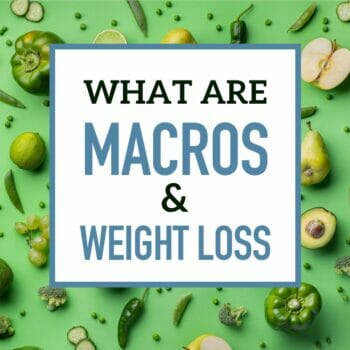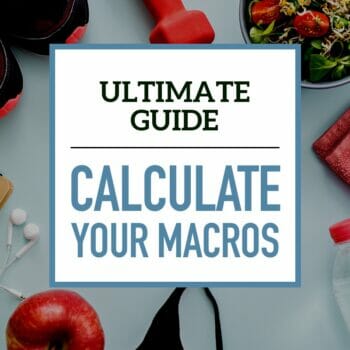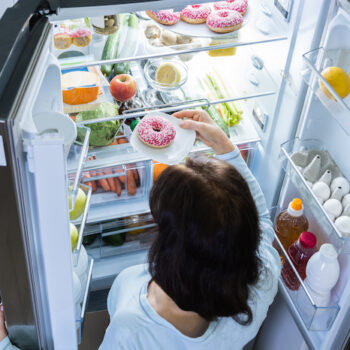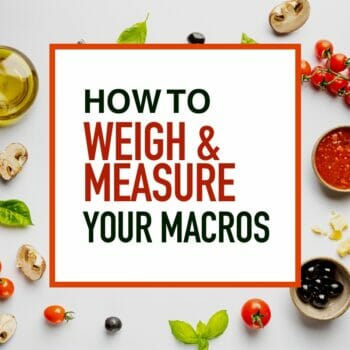How To Count Macros on a Vegan, Vegetarian, or Plant-Based Diet

Counting macros on a vegan or plant-based diet ensures you get all the nutrients your body needs to thrive.
Can you count macros when vegan or vegetarian?
Yes, most definitely.
Use a macro-based approach with any dietary preference.
The macro philosophy is about eating the foods you prefer – whether vegan, plant-based, or vegetarian.
There are, however, changes you can make to make reaching your goals easier.
A Comprehensive Vegan Macro Diet Plan
Download the system used by thousands of vegans and vegetarians to achieve lasting weight loss.

- Learn the 3 essential tools for tracking macros.
- Discover the number one problem with plant-based macros and how to overcome it.
- 10 full days of vegan & vegetarian meal plans.
- 25+ plant-based recipes.
- Join over 14,000 people using the macro method.
- Learn everything you need in 60 minutes.
– Bea
The best vegan macro ratios
- 25-30% protein
- 40-45% carbohydrates
- 30-35% fat
Getting the recommended amount of protein is one of the hardest parts of a plant-based diet, especially if you do strength training.
Eating more protein increases the rate at which you can add muscle mass.
However, you can still build muscle with fewer grams of protein (the process will take longer).
Many great athletes are vegan, and you would never know it by looking at their physiques.
How much fiber should I eat?
Plants are high in fiber, so vegetarians often get a lot of fiber throughout the day.
However, if you consume 30-50 g of fiber a day, you may need to eat more carbs to compensate for the indigestible nature of the fiber.
Compensating for high fiber intake
- Fiber is counted as a carbohydrate on food labels, but most of the fiber you eat can’t be broken down and doesn’t give your body energy.
- If you are active and trying to lose weight, you must fuel that activity properly – avoiding too much of a calorie deficit.
- Vegans should eat about 50-75% of their fiber intake back as more carbs.
Example
If you eat 50 grams of fiber daily, you need to eat 37.5 grams of digestible carbs to compensate for the indigestible carbs.
You could track net carbs in your app. Unfortunately, not all apps track net carbs, and it makes the process too complex! 😒
Do vegans need to eat more calories?
No, vegans have the same calorie requirements as any other person.
The difference is that vegans need to account for all the fiber they eat (as discussed above).
Vegan and vegetarian macro meal plan
Here’s a sample meal plan for both a rest day and workout day.
Eating more on a workout day fuels your workouts, and you compensate by eating less on a rest day.
Rest Day
Breakfast
- 1/2 cup cooked oatmeal (1/4 cup raw)
- 1/2 cup frozen blueberries
- 1 scoop vanilla Vega protein powder (or similar)
Snack
- 1 banana with 2 tablespoons natural peanut butter
Lunch
- 1 cup Campbell’s Organic Lentil Soup (or similar)
- 1.5 cups broccoli
- 1-ounce walnuts
Dinner
Stir fry: Saute the veggies in a nonstick skillet until they are slightly tender. Toss in the Seiten and seasonings. Stir till heated. Serve over cooked quinoa.
- 5 ounces Seiten
- 2 tsp olive oil
- 1 cup chopped mushrooms
- 1 red bell pepper
- 1 cup onion
- 1/2 cup cooked quinoa
- Garlic, ginger, and soy sauce to taste.
- 2 clementines (to offset undigestable fiber grams)
Total 1547 calories
Macros
- Protein: 99 g (25%)
- Carbs: 173 g (45%)
- Fat: 51 g (30%)
- Fiber: 34 g
Exercise Day
Breakfast
- 1 slice of whole-wheat toast
- 1/2 cup vegan refried beans
- 1/2 medium sliced avocado
Snack
- 1-ounce almonds
Lunch
- 6 ounces Tofu
- 4 cups spring salad mix
- 2 tablespoons balsamic vinaigrette dressing
- 1 medium apple
Snack
- Vega protein shake (2 scoops) (preferably after your exercise)
Dinner
- 1 cup white beans
- 2 cup zucchini
- 3 mini sweet peppers
- Sauté the above with 2 teaspoons olive oil
- 2 ounce whole wheat pasta (1 oz offsets the undigestible fiber grams )
- Top with 1 cup organic marinara (Trader Joe’s)
- 2 squares dark chocolate (72%)
Total: 1940 calories
Macros
- Protein: 119 g (25%)
- Carbs: 204 g (42%)
- Fat: 72 g (33%)
- Fiber: 42 g
How to get enough plant-based protein
Many plant protein sources lack all essential amino acids, making it difficult to get enough complete protein.
How to combine plant proteins
Eat a legume along with grain.
Example
- Beans and rice
- Lentils and rice
- Hummus on whole-grain toast
Vegan foods high in protein
Here are some superstars:
- Grains: Lentils, quinoa, seitan, amaranth, chickpeas
- Legumes: black beans, green beans, green peas
- Seeds: hemp seeds, pumpkin seeds, chia seed
- Soy: tofu, edamame, tempeh.
The more densely the food is in protein the less impact it will have on your other macros.
Plant-based protein supplements
If you’re trying to build muscle, protein supplementation will really help. Most are pea-protein based. Flavor and texture has gradually been improving.
Choose a brand that is:
- at least 20 grams of protein per scoop.
- low in carbs and fat.
I’ve tried Vega Sport Protein. Kos is another one to try.
More resources
- See a 5-day vegetarian meal plan.
References
- Moore, D. R., Robinson, M. J., Fry, J. L., Tang, J. E., Glover, E. I., Wilkinson, S. B., ... & Phillips, S. M. (2009). Ingested protein dose response of muscle and albumin protein synthesis after resistance exercise in young men. The American journal of clinical nutrition, 89(1), 161-168.

 What Are Macros For Weight Loss?
What Are Macros For Weight Loss? How to Calculate Your Macros for Body Transformation
How to Calculate Your Macros for Body Transformation Drinking Alcohol and Counting Macros
Drinking Alcohol and Counting Macros Help, I’m Hungry on a Macros Diet
Help, I’m Hungry on a Macros Diet How To Track Macros In the Foods You Eat Painlessly
How To Track Macros In the Foods You Eat Painlessly